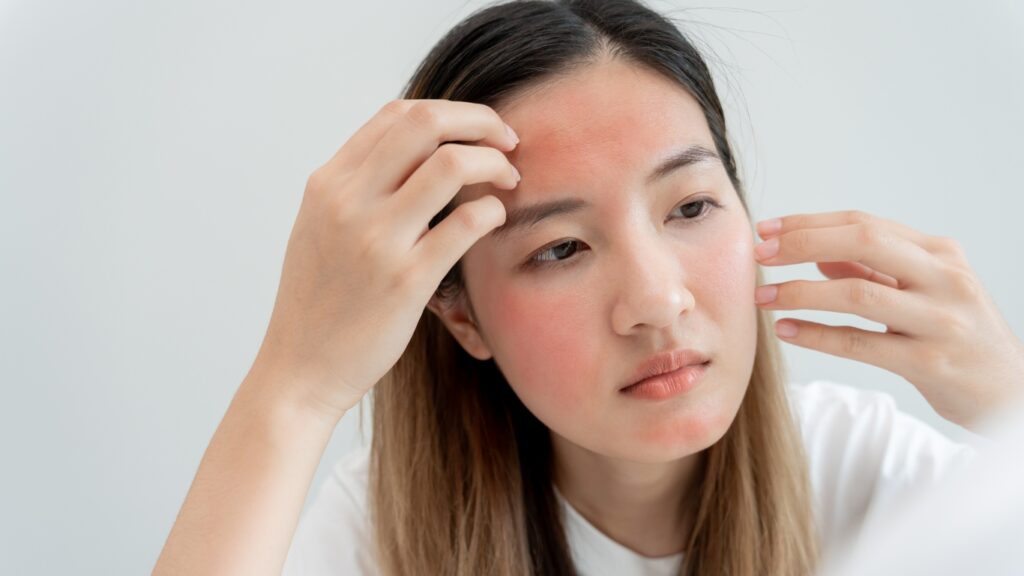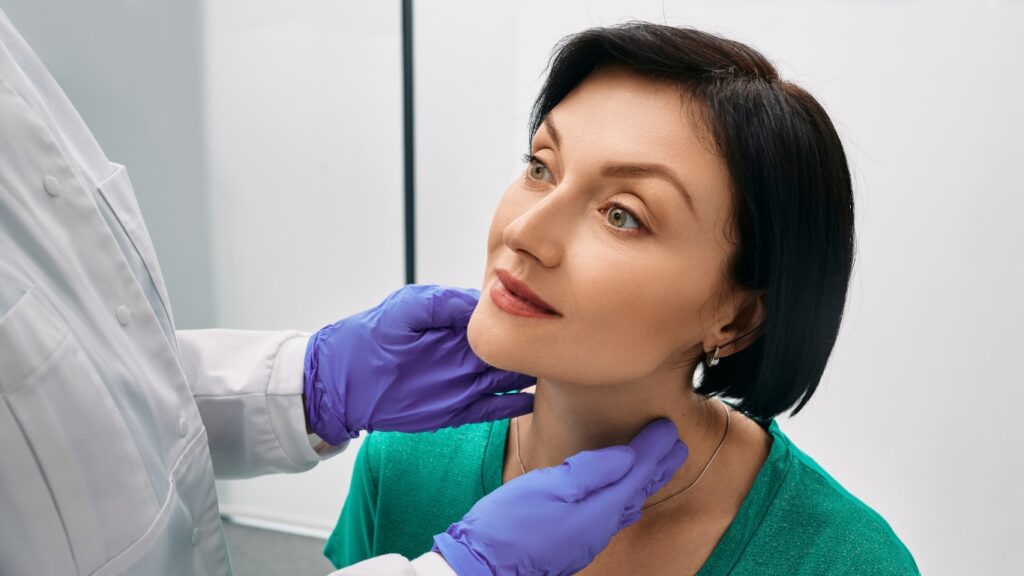
The thyroid gland is a small, butterfly-shaped gland located at the base of the neck. The thyroid gland plays a crucial role in regulating various metabolic processes in the body through the production and release of thyroid hormones. Thyroid hormones have a widespread impact on the body, including metabolism, growth and development, digestive system, bones, muscles, and skin health.
There are mainly two types of thyroid dysfunction-hypothyroidism (underactive thyroid and less thyroid hormone production), and hyperthyroidism (overactive thyroid and more thyroid hormone production). Both these conditions affect the skin in different ways. Let us see how these conditions affect your dermatological health.
HYPOTHYROIDISM
Hypothyroidism, or not producing enough thyroid hormones, can significantly impact various bodily functions, including the skin. Thyroid hormones play a crucial role in maintaining the skin’s health, and a deficiency can lead to several skin problems. Here are some common skin issues associated with hypothyroidism:
- Dry and Rough Skin: One of the most common skin manifestations of hypothyroidism is dry and rough skin. Reduced thyroid hormone levels slow down the metabolism, which decreases the production of sweat and oils that naturally moisturize the skin. As a result, the skin becomes dry, coarse, and scaly.
- Pale and Yellowish Tint: People with hypothyroidism often experience pale skin due to reduced blood flow and anemia. Additionally, the skin may take on a yellowish tint because of the accumulation of carotene, a precursor of vitamin A, which is not efficiently converted to vitamin A in the absence of sufficient thyroid hormones.
- Cold Intolerance: Hypothyroidism can cause the skin to feel cold to the touch due to decreased blood circulation and a slower metabolism. This can also make individuals more sensitive to cold temperatures.
- Swelling and Puffiness: Myxedema, a severe form of hypothyroidism, can cause the skin to become swollen and puffy. This is due to water retention.
- Hair and Nail Changes: Hypothyroidism can lead to hair becoming dry, brittle, and thinning, particularly on the scalp and eyebrows. Nails may become brittle, grow slowly, and develop ridges.
- Eczema and Dermatitis: Some individuals with hypothyroidism may develop eczema or dermatitis, conditions characterized by inflamed, itchy, and irritated skin. This is partly due to the impaired immune function associated with low thyroid hormone levels.
- Slow Wound Healing: Low thyroid hormone levels can impair the skin’s ability to heal wounds efficiently. This is due to reduced cell turnover and impaired collagen synthesis, which are essential for skin repair.
- Increased Bruising: Hypothyroidism can sometimes lead to increased bruising. This is often linked to reduced blood clotting factors and weakened capillaries.
Management and Treatment
Managing skin problems associated with hypothyroidism involves addressing the underlying thyroid hormone deficiency. Here are some key approaches:
Thyroid Hormone Replacement: The primary treatment for hypothyroidism is thyroid hormone replacement therapy, typically with synthetic levothyroxine. Restoring normal thyroid hormone levels can help alleviate many skin-related symptoms.
Skincare Routine: Using gentle, hydrating skincare products can help manage dryness and irritation. Moisturizers containing ingredients like hyaluronic acid, glycerine, and ceramides can be particularly beneficial.
That was about hypothyroidism, now let us see what happens in Hyperthyroidism, or the production of excessive thyroid hormones.
HYPERTHYROIDISM
The oversupply of thyroid hormones accelerates bodily functions. This increased activity leads to increased blood flow, metabolic rate, and cell growth. The skin changes associated with hyperthyroidism are also due to the increased metabolic rate and immune system activity. Here are some common skin issues observed in hyperthyroidism:
Warm, Moist Skin: One of the most noticeable skin changes in hyperthyroidism is warm and moist skin due to increased blood flow and sweating.
Thinning Skin: The skin may become thinner and more fragile, leading to easy bruising and a higher risk of injury.
Increased Sweating: Excessive sweating (hyperhidrosis) is common due to the overactive metabolism.
Pruritus (Itching): Generalized itching is often reported, which can be quite uncomfortable.
Hives (Urticaria): Painless, raised patches of skin, often accompanied by itching, maybe there.
Hyperpigmentation: Some individuals may develop darkening of the skin, particularly in areas prone to friction.
Hair and Nail Changes: Hair may become fine and brittle.Nails may grow faster but be more brittle, and some people develop onycholysis (separation of the nail from the nail bed).
Pretibial Myxedema: This is a specific skin condition associated with Graves’ disease (an autoimmune form of hyperthyroidism). It presents as thickened, reddish, and swollen skin, typically on the shins.
Vitiligo: There can be an increased incidence of vitiligo, an autoimmune condition characterized by patches of skin losing their pigment.
Dermographism: This is a condition where slight scratching of the skin causes raised, red lines.
Effective management involves addressing the underlying thyroid imbalance and treating the specific skin symptoms. Here are some strategies:

Management and Treatment
Antithyroid Medications: Drugs like methimazole or propylthiouracil can reduce thyroid hormone production, helping to alleviate skin symptoms.
Beta-Blockers: These can help control symptoms like sweating and itching by managing the overall hyperthyroid condition.
Radioactive Iodine Therapy: This treatment destroys overactive thyroid cells, helping to normalize thyroid function and improve skin conditions.
Thyroid Surgery: In severe cases, partial or total removal of the thyroid gland may be necessary.
Skincare: Use emollient-rich moisturizers to help with dryness and itching.Over-the-counter hydrocortisone creams or antihistamines can reduce itching and inflammation. Applying cool, damp cloths to affected areas can provide temporary relief from itching and hives.If scalp issues are present, using shampoos containing selenium sulfide, zinc pyrithione, or ketoconazole can help.
Lifestyle Adjustments: Gentle cleansing with mild, fragrance-free soaps can prevent irritation. Identify and avoid potential irritants such as certain fabrics, soaps, and stress, which can exacerbate skin symptoms.Omega-3 fatty acids, vitamin D, and vitamin E can be beneficial for skin health but consult with a healthcare provider before starting any new supplements.
Whether it is hypothyroidism or hyperthyroidism it is important to have regular medical check-ups with your doctor. Frequent visits to an endocrinologist can help monitor thyroid levels and adjust treatments as needed. For persistent or severe skin issues, seeing a dermatologist is advisable. Consuming a diet rich in vitamins and minerals, particularly those that support skin health such as vitamins A, C, E, and zinc, can improve skin condition. Staying well-hydrated can help maintain skin moisture.
Stress Management is also extremely important in today’s times. Practices yoga, meditation, and deep-breathing exercises to reduce stress, which may help alleviate skin symptoms.
By combining medical treatments with skin-specific care and lifestyle adjustments, individuals with hyperthyroidism can effectively manage their skin issues.